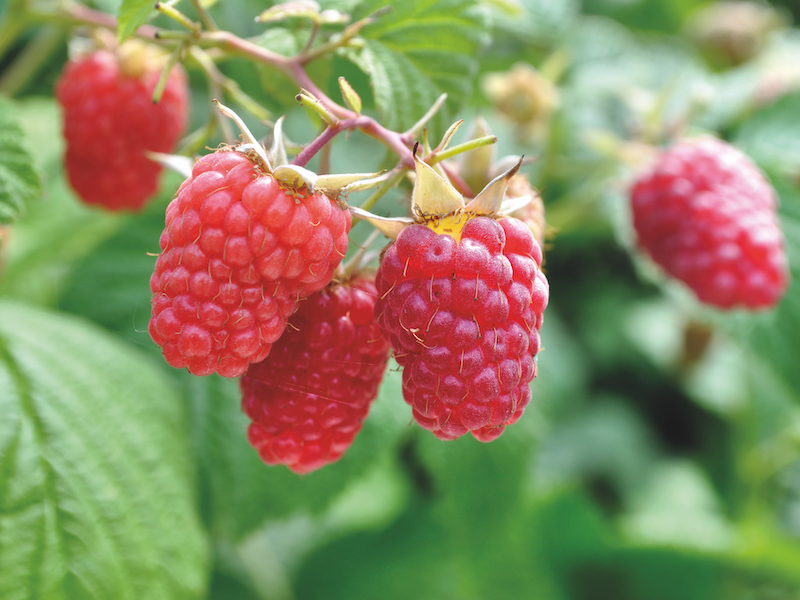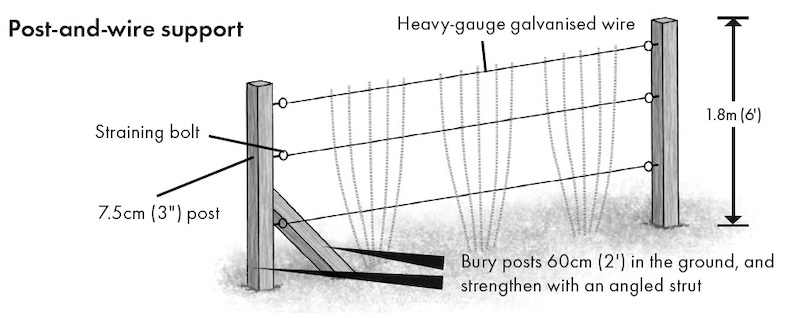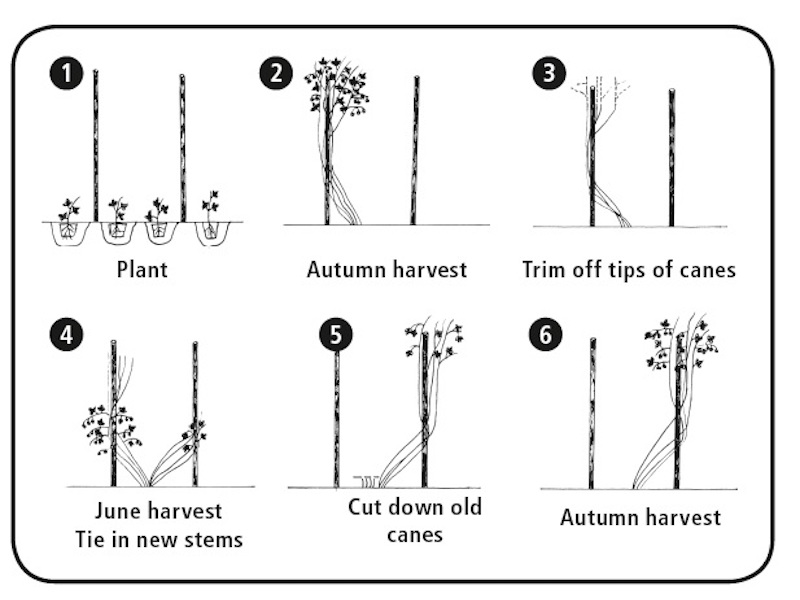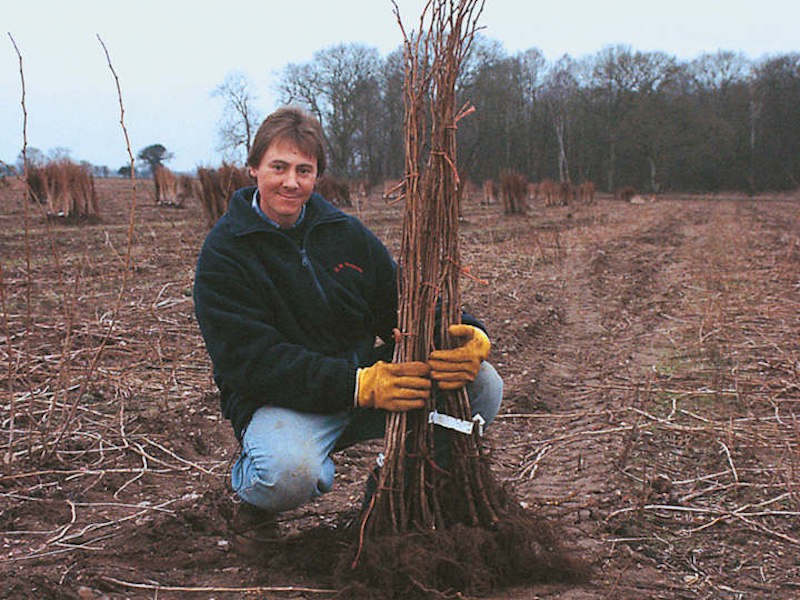Summer-fruiting raspberries are easy to grow in gardens, allotments or even patio containers. They produce berries from June, and just a few plants can generate a huge crop! Here are our top tips on how to successfully plant, prune and grow your own delicious summer-fruiting raspberry canes.
How to support summer-fruiting raspberries
Popular summer-fruiting raspberry varieties like ‘Glen Ample’ and ‘Glen Prosen’ grow to a height of around 1.8 metres (6′) or more, and therefore require some form of support. The simplest method for small gardens is to tie the long stems (known as canes) into horizontal wires on a wall, fence or garden shed.
If you have enough space, the best way to plant your raspberries is in rows running north to south in the open garden, as this allows maximum light to penetrate the crop. Position your rows 1.8m apart and anchor stout posts at each end. As they grow, the raspberry canes can be tied into heavy-gauge galvanised wire strung between the posts.
Ideally your posts would be 2.4 metres (8′) long with about 60cm (2′) buried below soil level. Stretch three strands of heavy gauge wire horizontally between the posts at heights of 60cm (2′), 1.2 metres (4′) and 1.65 metres (5½’) above ground level. Cross brace the end posts with struts at 45° so that they withstand the wire tension.
Bear in mind that you may need to protect your ripening fruits from birds. Position them so that a cage or netting can be easily erected over the plants if required.
How to plant summer-fruiting raspberries
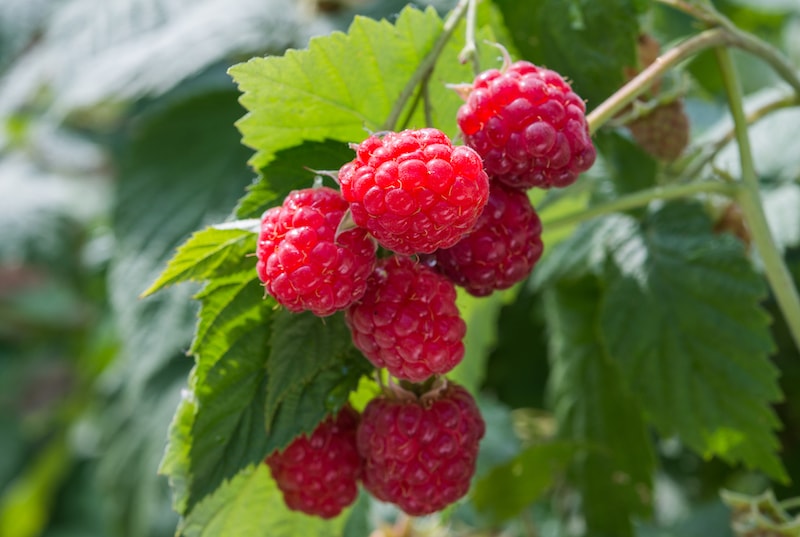
Image: Raspberry ‘Glen Ample’ from Suttons
Raspberries can be planted at any time during their dormant period, as long as the soil isn’t too wet or frozen. After preparing the ground, it’s best to allow the soil to settle for a week or two. Soak the roots in tepid water for a few hours prior to planting, if at all dry.
Raspberry canes should be planted 45cm (18″) apart and a garden line should be used to ensure that the row is straight. Dig a hole large enough to accommodate the root system and set the plants so that the roots are covered by about 8cm (3″) of soil. Gradually fill the soil around the roots and firm well. Take care not to damage any young, new shoots which are developing among the roots. If hard frosts occur, newly planted material may need re-firming after the thaw. For pot grown raspberry plants, gently tease out the roots and plant so that they are 2.5–4cm (1–2″) deeper than the compost level.
Before or immediately after planting your raspberries, prune the canes to 22cm (9″) from the ground. When new shoots have developed from the base of the plants and they’re about 20cm (8″) tall, cut down what remains of the old canes to ground level.
If your new raspberries arrive and you don’t have time to plant them straight away, temporarily ‘heel’ in the bare root plants. To do this, dig a shallow V-shaped trench, set the plants close together along one side, replace the soil and firm it around the roots.
How to train and prune summer-fruiting raspberries
Summer-fruiting raspberry varieties produce fruit on the previous year’s growth, and so careful pruning is required to avoid accidentally losing your crop.
Newly planted raspberries don’t produce any fruit in their first season. However, they do start to produce the canes that will carry next year’s fruit. As they develop, tie these new canes to the wires. At the end of the first summer, cut any weak canes down to soil level – but retain the strong ones. Traditionally, these strong canes were lightly pruned in February by cutting them back to a growth bud about 15cm (6″) above the top wire. However, recent research has shown that shortening the cane length by more than 15 cm (6″) reduces crop yield and, to avoid this, the tips of long canes should be bowed over and tied down to the top wire.
In the year following planting (the second season), further new canes develop from ground level. Initially, while the old canes are fruiting, the new ones may need a loop or two of twine to keep them upright. Once harvesting has been completed, remove the old canes entirely, pruning down to soil level.
Cut out any weak, new growth and any surplus strong canes so that you’re left with about 6 of the strongest canes per plant. Tie them to the wires and space them 8-10cm (3-4″) apart along the top wire. Canes that develop well away from the plants and between rows should be pulled up while they’re small to minimise competition. The sequence of old cane removal and the tying in of new canes is repeated each year.
How to feed and care for summer-fruiting raspberries
In March, apply sulphate of potash at 35g per sq. metre (1oz per sq. yard) and sulphate of ammonia at 15g per sq. metre (½oz per sq. yard) to your raspberries. Poor growth and pale green foliage are a likely indication of nitrogen shortage, in which case a further application of sulphate of ammonia can be given in the late spring. Every two or three years, use a general fertiliser in March instead of separate fertilisers. In late April when the soil is moist, apply a surface layer (mulch) of well rotted manure or garden compost.
Ensure that your raspberry plants have plenty of water as they get established, and again during the months of June and July when fruits and new canes are developing. Apply a minimum of 10-15 litres per sq. metre (2-3 gallons per sq. yard) each time you water. Keep annual weeds under control by light hoeing, but be careful not to harm the shallow roots of your raspberries.
What are long cane raspberries?
These special varietes are delivered with most of the mature wood from the previous season still intact. Because the fruit is produced on last year’s growth, this means that you won’t have to wait very long for your first crop. The technique was developed to allow commercial plantations to yield fruit more quickly and get more revenue from a crop. It also allows gardeners to pick fruit in a matter of weeks from planting.
As a large amount of leaves quickly develop on canes that have very little new root, it’s crucial to provide them with plenty of water, particularly in the first year. Once fruiting has finished, treat these raspberry canes as a regular summer-fruiting variety.
We hope you’ve found our guide to growing summer-fruiting raspberries helpful. If you plant them alongside autumn-fruiting varieties, you’ll extend your growing season from June through to October. Share your raspberry images with us via social media, we love to hear from you! And if you’re growing autumn-fruiting (primocane) raspberries, read our helpful growing guide today.
Lead image: Raspberry (Rubus idaeus) Glen Prosen from Suttons
Last Updated on September 15, 2025 by Suttons Horticultural Team

